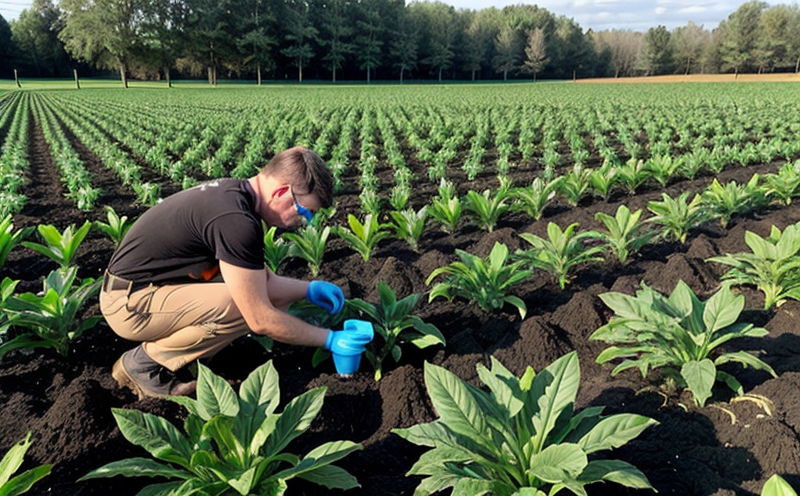Fertilizer Nutrient Release Rate Testing
In agriculture and forestry testing, nutrient release rate testing is a critical component of ensuring that fertilizers are effective and environmentally responsible. This service involves assessing the rate at which nutrients in fertilizers become available for plant uptake over time. The primary goal is to ensure that the released nutrients match the growth requirements of crops or forests without causing environmental harm.
The testing process typically begins with sample preparation, where a representative portion of the fertilizer sample is collected and analyzed. This ensures that the results reflect the actual performance of the product in use. The next step involves placing the fertilizer samples into controlled environments designed to mimic real-world conditions, such as soil or water systems.
Once placed, these samples are subjected to various environmental factors—such as temperature, humidity, and pH levels—that can influence nutrient release rates. These conditions simulate different agricultural and forestry settings, from temperate climates to tropical regions. Monitoring devices track the nutrient availability over time, providing detailed data on how quickly or slowly nutrients become accessible.
The testing apparatus used includes specialized incubators and spectrophotometers capable of measuring dissolved nutrients in soil leachates or water extracts. These instruments allow for precise quantification of nitrogen (N), phosphorus (P), potassium (K), and other essential elements as they are released from the fertilizer.
Acceptance criteria vary depending on the specific type of fertilizer being tested and its intended application. For instance, controlled-release fertilizers may have slower release rates compared to quick-release varieties, which need to provide nutrients rapidly for immediate plant uptake. Compliance with international standards like ISO 17259 or ASTM D3460 ensures that testing methods are consistent across different laboratories.
By understanding nutrient release rates, farmers and foresters can make informed decisions about when and how much fertilizer to apply, reducing waste while maximizing yield. This approach not only enhances productivity but also contributes positively to environmental sustainability by minimizing runoff into water bodies.
- Reduces Environmental Impact: By controlling nutrient release rates, there is less likelihood of excess nutrients entering nearby streams or groundwater sources.
- Promotes Efficient Use: Tailoring fertilizer application to plant needs prevents overuse and subsequent waste.
- Saves Resources: Precise dosing helps in optimizing resource utilization, whether it be water, land, or labor.
Why It Matters
The importance of fertilizer nutrient release rate testing cannot be overstated. Properly timed and quantified nutrient delivery is essential for sustainable agricultural practices that support both economic growth and ecological balance.
When nutrients are released too quickly, they can leach away from the root zone into groundwater or surface water, leading to pollution and potentially harming aquatic ecosystems. Conversely, if release rates are too slow, plants may experience nutrient deficiencies, stunting their growth and reducing yields.
In forestry applications, understanding nutrient availability helps in planning tree planting activities more effectively, ensuring that young saplings receive the necessary nutrients for healthy establishment without causing soil imbalance issues later on.
From a regulatory perspective, compliance with standards ensures that products are safe for use and contribute positively to public health and environmental protection. It also supports fair competition among manufacturers who adhere to best practices in their production processes.
Environmental and Sustainability Contributions
- Promotes Sustainable Agriculture: By minimizing nutrient runoff, this testing promotes healthier soil conditions which support long-term productivity without degrading natural habitats.
- Fosters Greenhouse Gas Reduction: Efficient use of fertilizers reduces the need for additional synthetic inputs, thereby lowering greenhouse gas emissions associated with their production and transport.
- Supports Biodiversity: Healthy soils rich in organic matter are better able to support diverse plant communities, which in turn foster greater biodiversity within agricultural landscapes.
Use Cases and Application Examples
This testing is particularly valuable for several types of fertilizers:
- Controlled-Release Fertilizers: These products are designed to deliver nutrients gradually over extended periods, typically ranging from weeks to months. Testing helps verify the release pattern aligns with intended specifications.
- Soluble Fertilizers: Used in hydroponic systems or as top-dressings on established crops, these fertilizers need rapid nutrient availability immediately upon application.
- Organic Amendments: While not strictly fertilizers, organic amendments like compost and manure benefit from release rate testing to ensure their efficacy over time.
In practice, this service supports various stakeholders including farmers, nurseries, golf course managers, and researchers studying soil health. For example, a nursery might want to confirm that its fertilizer treatments promote robust growth of young trees without causing excessive runoff into nearby waterways. Researchers could use these data points to refine models predicting nutrient cycling in different ecosystems.
Additionally, this testing plays an integral role in product development by providing insights into formulation adjustments needed for optimal performance under diverse environmental conditions.





